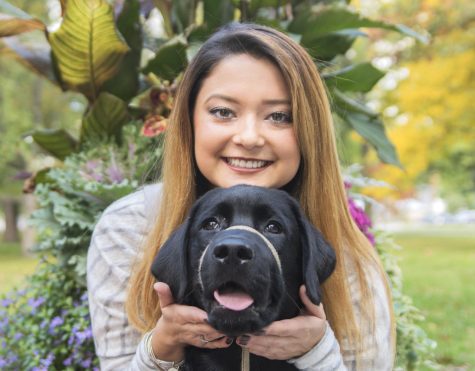Map your ‘Green Dot Moment’
September 23, 2014
Red dots fill infographics of maps, each one representing some type of horror — crimes, diseases, death or other depressing statistics.
Kent State’s Green Dot program aims to fill the map of our community with green dots, representing positive changes regarding power-based personal violence.
Jennie O’Connell, education intervention coordinator for the Sexual and Relationship Violence Support Services (SRVSS) of the Women’s Center, defines power-based personal violence as any situation in which one person gains power over another individual.
O’Connell said, “Green Dot is a university-wide initiative from the Division of Diversity, Equity and Inclusion which is being overseen through the office of Sexual and Relationship Violence Support Services.”
She said its focus is on sexual assault and intimate partner violence.
The Green Dot campaign has two components: a skill-based workshop and campus messaging. Students, faculty and staff can register for the free eight-hour skills workshops, which teach participants how to be proactive and reactive bystanders when presented with a situation that makes you feel uncomfortable or even concerned for someone’s safety.
Campus messaging also plays a large role in Green Dot.
“We’re really trying to change the message around violence and sexual violence,” O’Connell said. “We’re promoting safety, promoting being active bystanders and contributing citizens of our community, being engaged and making a difference on our campus.”
Green Dot aims to teach students how to intervene in a variety of very relevant situations in the lives of college students, including stopping intoxicated females from entering compromising situations and watching for students who are clearly trying to escape a potentially threatening situation.
“I went through training because I felt like I didn’t have enough information and knowledge to handle situations in which being a bystander is necessary,” said Abigail Yackley, a junior communication studies major. “Having the information and knowledge makes me feel safer.”
While Green Dot promotes intervention, the methods taught can be adapted to all comfort levels. Confrontation is not always necessary in one of these situations; O’Connell said it could be something as simple as checking in on a peer or distracting him or her from a situation.
Two student training sessions have already been held this year, with two more scheduled in October that students can attend.
“Once you go through the training, you start to view the world through the Green Dot lens,” O’Connell said. You begin to notice things around you and look inside yourself to determine if you should interfere in any situation that catches your attention and how you are most comfortable doing it.”
After researching multiple bystander programs, the SRVSS office chose to implement Green Dot at Kent State because it is not a program that tries to change who students are, but a program that encourages students to look at who they are, who they want to be and how to use the skills they have to stop a case of power-based personal violence.
At a recent student training session, facilitators asked participants what it meant to be a Kent State student.
“Kent State is about caring about one another. People said that when they first got to campus people were willing to help, people were willing to support each other,” O’Connell said. “The message of Green Dot and the ultimate goal of Green Dot about being a more caring community already fits with who we are.”
Multiple groups on campus have already undergone training. Residence Services, Office of Health Promotion and the Women’s Center staffs are all heavily involved. One professor is even having her Gender and Communication course take the training.
Students can register individually or have a specific student organization register as a group to receive a training session. O’Connell said they are reaching out to large student organizations such as Greek life, student athletic teams and student leader programs across campus to receive training and start spreading the Green Dot message.
Facilitators consider Green Dot to be much more than just a campus program. O’Connell said Green Dot is considered a social movement, one that can start a chain reaction by actively engaging students on campus.
“I don’t think that you can ever be too aware of what’s happening around you, and Green Dot helps you become more self-aware as well as aware of what’s happening all around you,” Yackley said. “It encourages people to make smart choices, and I think that overall, it will make campus, and even the city of Kent, a safer place.”
Green Dot will be hosting a launch event Wednesday, Sept. 24 from 2 to 6 p.m. in Risman Plaza to spread its message and get students involved. The first 100 students to attend will receive a free T-shirt. The casual event will be filled with a variety of games and activities for students to participate in, along with gift card raffles for Chipotle and other places.
“It will just be a fun event to raise awareness and get the Green Dot message out there on campus,” O’Connell said.
Students who are already doing green dot behaviors can go to the Green Dot website to add their own green dot to a Kent State map and to get more information about registering for training sessions.
The next Green Dot session will be held during two days of training Oct. 3 and 4 from 9 a.m. to 1 p.m., and the following session will be held on Oct. 24 from 8:30 a.m. to 4:30 p.m. A special two-day session for Kent State faculty and staff will be held Nov. 24 and 25 from 8:30 a.m. to noon.
Contact Erin Zaranec at [email protected].
























